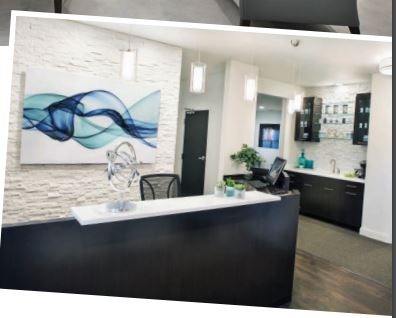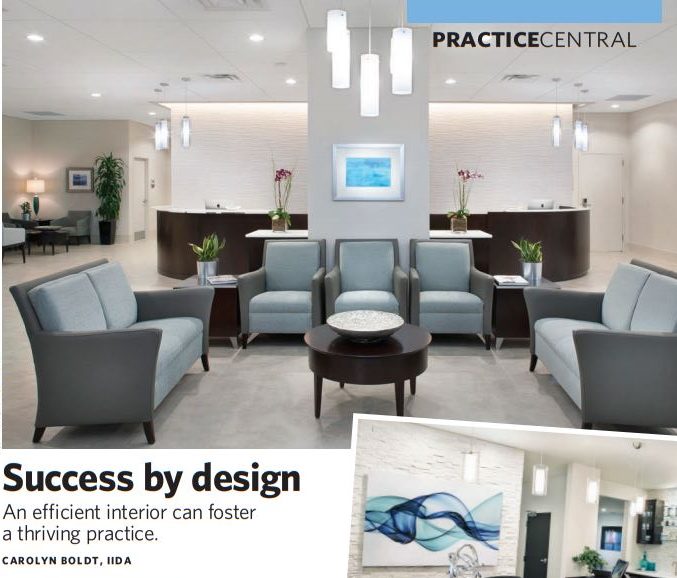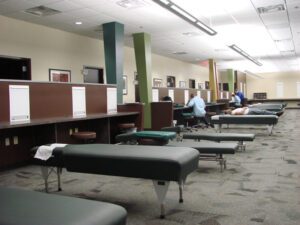CrossFields is thrilled to have been featured multiple times in issues of Chiropractic Economics.
Read our latest article here or below.
How to create an efficient interior to foster a thriving practice
Ideally, the design of your practice should increase the success of your business.
Consequently, the success of your practice is directly related to the quality of your space. And the quality of your space is shaped by the depth of forethought and experience that is put into the process of designing it. From your location, through the space plan, to the sound systems, every detail is important to the efficiency and effectiveness of the environment.
How do you achieve quality in the design of your office to elevate your success? Two key points must blend together for quality design to happen—efficiency and effectiveness. In the design world, this is called “function and form,” and a quality space incorporates both.
For the successful chiropractic office, efficiency is achieved through a comprehensive understanding of the “function,” while the effectiveness of the space is accomplished through the creation of the “form” that conveys the practice mission and desired image and creates a culture.
The architect Louis Sullivan coined the phrase, “form follows function,” thus we start with function.
Finding the function
A highly functional and efficient space maximizes the square footage available and streamlines the flow of work. Consider how these are related.

Maximizing the space: Every square foot of space is an expense. You want to make sure you don’t have too much space, as this will be a waste, and yet you need to balance that against having too little space to function properly. There is a fine balance between the two.
Start with calculations and ideal sizes for each space. The size needed for each space is determined by the activities, people, and items it will contain. Each piece of equipment has a minimum ideal space around it for use. Too little space will slow down your efficiency and create discomfort for your patients. Too much space is an obvious waste of money. Each case must be analyzed.
For example, sometimes the number of spaces desired can be achieved by shaving inches off the ideal size of each space, which can free up space for another functional room. This slightly below ideal-sized space could still be functional by using custom smaller work cabinets or mounts that use vertical space instead of floor space—this is the theory of open office design.
Custom-built cabinets and quality mounting equipment are also an expense; that cost must be weighed as well. Typically, when there is a choice, you will find that the money spent on such items in the space that is undersized or the cost of the rent of a slightly larger space is a better choice than space that is not efficiently used.
Streamlining the flow: The flow of your space impacts your efficiency and thus your productivity. Flow is best created by clearly defining both desired space adjacencies and the flow of people through the space.
Space adjacencies are categorized to the designer as primary and secondary. A primary adjacency would be those spaces that must be next to each other to support the function of each space. The most obvious primary adjacency is the waiting space next to the front desk. A secondary adjacency would be a lower priority, but it is still important. An example of this for some practices is that the adjusting room is ideally close to the exam room.
The people flow in a typical chiropractic office consists of new patients, existing patients, and the staff. The new patient, often on day one, day two, etc., is typically escorted through the space and the flow is part of the first impression. Existing patients are typically unescorted, and the key here is to define the flow so it is not confusing, is efficient in the patient care process, and does not detract from the new patient experience or interfere with staff flow.
The staff flow is the most important. Wasted time is a direct expense to the practice, and it is frustrating to the doctors and staff.
Good flow and efficiency are also embodied in the thoroughness of thinking through the ergonomics of the space, the users, the details (such as the location of electrical outlets), implementing the sound system, and determining storage needs.
Every space and practice is unique and the decision of the placement of the rooms and areas within a space becomes a hierarchy of needs, intentional decisions, and compromises. In general, there are about 10 to 15 different viable configurations of a space, and each needs to be explored to determine what will maximize the space and the flow.
Finding the form
The form creates the environment. While the functional aspects and space plan are measurable, the environment is more experiential and emotional. The effectiveness of the design is found in its ability to attract and retain your ideal patient and be a successful practice environment.
The form encompasses the three- dimensional aesthetic space that builds up from the floorplan in the elevation of the walls, ceilings, etc. It should never be a secondary thought, but rather an integrated initial purposeful thought inherent to the interior and architectural design.
In designing a quality space, consider the key principles of design—defined as balance, emphasis, proportion, rhythm, and harmony.
For example, a well-designed space is always balanced, but the intentional use of a specific type of balance evokes different reactions, such as authority in symmetrical balance, a homelike comfort through informal balance, or a sense of community in a radial balance.
To further enhance an effective environment, quality design uses such elements as line, shape, volume, scale, texture, pattern, light, and color to promote the desired response. Each element can have a variety of effects.
Using the design element of line as an example, a dominant lower horizontal line will make you want to sit down, while a vertical line will make you want to stand up. You’ll likely find that color and lighting are the two elements that achieve the highest return on investment when creating an effective space.
Still, the well- designed space is not based on one or two elements, but the total composition of these items, while following good design principles.
The successful chiropractic office environment is not just a pretty space; it is a powerful representation of your internal image. It either breeds success or detracts from it.
Does your office environment represent the quality and vision of your practice well?
Schedule a Complimentary Consultation to speak with someone more about your design success!






